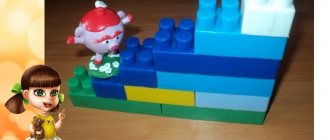Special exercises for clarity of diction.
Perform the exercises daily and several times. The room should be comfortable, no strangers, not even animals. It is best to do it comprehensively, that is, today one exercise, and tomorrow another, and then do everything in turn.
"Elephant's trunk" . Extend your lips with a tube as far as possible. Now you need to rotate the resulting “proboscis” several times left and right, clockwise and counterclockwise.
"Smile" . Having stretched your lips as wide as possible, fix them in this position for 7-10 seconds. Then return your lips to their normal position and repeat the exercise several times.
Alternating the two previous exercises. Take your time, take your time and fix your lips in tense and relaxed positions.
"Crossroads" . Here you need to open your mouth, smile, then touch the corners of your mouth with the tip of your tongue, first at the lower teeth, then at the upper teeth.
"Spatula and Needle" .
Open your mouth slightly and smile wider. Place your tongue on your lower lip and try to relax it as much as possible. After a few seconds of this position, tense your tongue and use it, figuratively speaking, as a needle: make 5-7 “stabbing” movements with it.
TYPES OF SPEECH DEFECTS
There are several types of speech impairment. Some of them occur more often, and some occur in isolated cases, so working on them will be more difficult and longer.
Dislalia
One of the most common speech problems. A person with such a defect is characterized by a large vocabulary, the ability to construct and coordinate even complex long sentences, but at the same time may make mistakes in the pronunciation of individual sounds.
The defect belongs to the phonetic group (pronunciation is impaired). People with this disease do not have hearing problems.
Dysarthria
The disease is characterized by errors in the pronunciation of almost all sound groups. The cause of this problem lies in the disruption of the nerves connecting the speech apparatus and the nervous system. With this diagnosis, the work of such nerves is insufficient.
Dysarthria is characterized by the following features of human speech:
- incorrect intonation, rhythm and tempo of speech;
- slurred speech;
- problems with voice production.
Rhinolalia
The problem manifests itself in a violation of the timbre of a person’s voice. Remember how in childhood everyone tried to imitate an elephant (say “on the nose”). So in people with rhinolalia this happens involuntarily.
Nasal sound occurs due to anatomical disorders of the speech apparatus.
Stuttering
Characterized by disturbances in the rhythm, fluency and tempo of speech. Stuttering occurs due to spasms of the facial muscles and usually occurs from the age of two. The disease has the following features:
- sudden stop during a conversation;
- repetition of syllables or individual sounds;
- adding unnecessary sounds to words.
As the problem of stuttering occurs more and more often, it is important to know about the rules for preventing this disease. Moreover, you need to follow the recommendations constantly, and not just when the baby starts talking. That is, already at the time when the child is six months old, it is necessary to clearly monitor his own speech and manner of speaking. Everyone who surrounds the child must speak clearly, distinctly and understandably; in no case should you rush to swallow sounds and words. You should also adhere to the following recommendations:
- Avoid contact with people who stutter if possible.
- In front of a child, you should not make a scene or speak in a raised voice, much less shout.
- Avoid injury, especially to the head. It is important to ensure that the child does not receive psychological trauma.
- Do not overload your child with a lot of information and emotions, even positive ones.
- Do not try to make a child prodigy out of your child, do not overload him with activities.
- Avoid things that might frighten your child (movies or scary stories).
- Do not hit your child or choose to be alone in a dark room as punishment.
Alalia
Alalia is understood as the absence of speech in children from 3 to 5 years old. Absence can be partial or complete. The disease is caused by damage or underdevelopment of the area of the left hemisphere responsible for development. The developmental disorder or damage can occur in the womb or in the first months after birth.
There are two types of alalia. With motor alalia, the child understands everything, but cannot say anything on his own. And with sensory, there is a misunderstanding of the other’s speech. Often with this diagnosis, the child chaotically repeats sounds or entire words of an adult. Correcting the defect is difficult and time consuming.
Mutism
This disease most often develops as a result of severe psychological trauma. In children with this diagnosis, speech development stops, they completely stop speaking.
There is general mutism, in which the child completely stops speaking, and selective mutism, which manifests itself in the form of a protest against certain circumstances or the actions of others.
Childhood autism
The disease is characterized not only by the cessation of the child’s speech, but also by his immersion in experiences, detachment from everything that is happening around him and the people around him.
In autism, there is also a lack of everyday skills. Features of the disease are:
- increased excitability (in some cases even manifestation of aggression);
- fixation on one thing (the baby eats, drinks and plays with only one thing, and the selection criterion is most often the appearance of the object);
- reluctance to contact peers and adults, even parents;
- a highly developed sense of fear (and the child may not be afraid of the dark, but the sound of an alarm clock, for example, terrifies him).
General speech underdevelopment (GSD)
Typically, such a diagnosis is made when it is not possible to diagnose a specific problem. By general underdevelopment of speech, experts mean speech disorders that affect grammar, phonetics and vocabulary.
OHP is characterized by a child’s small vocabulary, his inability to construct sentences according to age standards, as well as impaired pronunciation.
OHP is also diagnosed if the baby begins to speak late (between the ages of 3 and 5 years), cannot inflect words and distinguish sounds.
Exercises to correct burr.
There is a widespread belief that this defect is quite difficult, and sometimes even impossible, to correct, especially if the person is already an adult. Actually this is not true. What is the reason for the burr? Insufficient or frankly weak mobility of the tongue. In this regard, it is advisable, along with the basic exercises to correct burr, to develop the motor activity of the tongue.
"Clicking" . Imagine that you hear the clatter of horse hooves and try to imitate it. The pace of the exercise should be different, but do not allow the tip of the tongue to curl down.
"Car" . Place the handle of a spoon or toothbrush under your tongue so that it creates light vibrations. At the same time, pronounce the sound “D” for a minute, which, if done correctly, should be heard as “DR”. After 10-15 days, try to do without a pen: pretty soon you will probably be surprised to notice that the sound will sound like “R”.
"Tractor" .
Say this word several times, emphasizing the “R” sound in the first syllable. Do an exercise that seems simple every chance you get. It's very effective.
CAUSES OF DEFECTS
Any speech disorder has its own reasons. Depending on age, several groups of causes are distinguished.
Causes of the disorder in adults:
- severe stress;
- damage to the speech apparatus;
- trauma of a psychological or physical nature;
- contusions;
- surgical intervention;
- infectious diseases;
- deafness.
In children, speech impediment occurs for the following reasons:
- severe fear or stress;
- injury;
- neurological disorders;
- dysfunction of the central nervous system or cerebral palsy;
- infectious diseases;
- incorrect formation or damage to the speech apparatus;
- heredity;
- deafness.
Conventionally, all causes are divided into two groups: physiological (associated with damage to the articulatory apparatus) and neurological (characterized by damage to the areas of the brain that are responsible for speech and a disorder of the nervous system).
For clear pronunciation of sounds, both whistling and hissing.
— In order to eliminate the phenomenon, which is scientifically called sigmatism, it is necessary to “teach” the tongue to be in front, in the interdental space. When pronouncing whistling and hissing words, move the tip of your tongue as far as possible behind the lower incisors. And don’t be confused by the fact that the sound may be even more lisping than usual: when the tongue begins to properly direct the air, the sound will begin to become more similar to “C”.
— More often pronounce the syllables “sya”, “se”, “so”, “su” and the like, the first letter of which is “S”, and the second must be both a soft and a hard vowel. Having consolidated the skill of correct pronunciation of the sound “S”, work on “Z” and “C” in the same way.
SPEECH DEFECTS IN ADULTS
In adults, speech problems arise for two reasons:
- physiological (past illness, injury or concussion);
- psychological (fear, extreme anxiety or stress).
If the reasons are physiological, then you need to seek medical help (you will need surgery or the services of an otolaryngologist).
If you have psychological problems, you need to consult a psychiatrist or psychotherapist. However, do not forget about consulting a speech therapist or speech pathologist.
Treatment
Mode
If hesitations in a child’s speech are physiological in nature, it is necessary to organize an optimal general and speech regime: ensure sufficient daytime and night sleep, increase the time of walks in the fresh air. It is important to temporarily limit the flow of new information, minimize watching TV, computer games, and attending public events. In verbal communication, the following recommendations must be followed:
- do not focus the child’s attention on hesitations, do not ask him to repeat the word again;
- talk to the child calmly, quietly, a little slower than usual;
- use short phrases, simple words;
- practice singing, learn age-appropriate poetry with tapping rhythm or marching.
Psychological correction
Indicated for patients with emotional hesitations in speech, stuttering, tachylalia, and polternium. This direction of correctional work helps to reduce fixation on a speech defect, eliminate logophobia, mastery of new self-regulation mechanisms, and expand communication capabilities. The main methods of psychocorrectional work are sessions of psychotherapy and hypnosis, communication training, autogenic training.
Speech therapy correction
Taking into account the reasons underlying speech hesitations, classes are conducted on speech development, stuttering correction, overcoming tachylalia, etc. Logotherapy is aimed at developing a new speech stereotype and consolidating it in all communicative situations. The following methods and techniques are used in the work:
- Articulation gymnastics.
Exercises help strengthen the muscles of the speech apparatus, relieve excessive muscle tension during phonation, make articulatory movements more accurate, and form the necessary kinesthesia. Exercises are used for the muscles of the tongue, lips, palate, and facial muscles. Voice gymnastics promotes the development of voice strength and prosodic components. - Breathing exercises.
Correct speech breathing is the key to free, smooth speech. During the classes, diaphragmatic lower costal breathing is performed. Mastering the technique of speech breathing allows you to pronounce phrases of varying lengths without hesitation or pauses. - Speech therapy rhythm.
Logorhythmic exercises help normalize the tempo and rhythm of speech, synchronize breathing and articulation, and develop general motor skills. Classes are held with musical accompaniment. To practice the rhythm, marching, clapping, and jumping are used. - Classes using ICT.
Computer technologies are widely used in comprehensive work to overcome stuttering. They are based on the effect of biofeedback, help improve the quality and emotional coloring of speech, and eliminate hesitations.
Wellness activities
They are organized on the basis of a clinic or day neurological hospital. The goal is to normalize the regulatory function of the central nervous system and increase adaptation mechanisms. Patients with pathological hesitations in speech are prescribed:
- courses of drug therapy (sedatives, B vitamins, nootropics, anticonvulsants):
- physiotherapeutic procedures (electrophoresis with antispasmodics, electrosleep);
- water procedures (coniferous, carbon dioxide, oxygen baths, recreational swimming);
- massage (general medical, neurosedative, SHV);
- acupuncture;
- physiotherapy.
Diagnostics
The appearance of speech hesitations is a reason to immediately seek the advice of a speech therapist. The sooner their cause and nature are established, the more effective the therapeutic and corrective effect will be. Diagnostics consists of three blocks:
- Speech therapy examination.
Includes the study of oral speech, its tempo-rhythmic and intonation-melodic organization. The type of hesitation and the conditions for its occurrence are determined. The characteristics of voice and breathing are assessed. The task of speech therapy diagnostics is to differentiate non-convulsive hesitations from stuttering. - Neurological examination.
A consultation with a neurologist involves studying the medical history, identifying neuropsychic disorders and factors that caused the patient to hesitate in his speech. In order to exclude brain pathology, instrumental techniques are prescribed: EEG, EchoEG, cerebral MRI. - Psychological examination.
An analysis of the HMF is carried out: attention, memory, thinking. At this stage of diagnosis, attention is paid to the state of general and manual motor skills, various types of praxis, and gnosis. The patient’s personal characteristics, his reaction to his defect, and the presence of fear of speech are analyzed.
SPEECH DEFECTS IN CHILDREN
It is believed that the peak activity of a child’s speech development occurs at 2.5-5 years. A normally developed child at the age of three should already be able to express himself in coherent sentences. A child should speak at least 5-10 words per year; by 4 years, the vocabulary should be at the level of 1000 words.
Up to 3 years of age, burr and lisp are not considered a speech defect and are explained by insufficient development of the articulatory apparatus (the tongue is most often located between the teeth when speaking). To eliminate these phenomena, parents are advised to carefully, unobtrusively correct errors in pronunciation, regularly pronounce words with errors, or work on individual sounds. If he hasn’t spoken before the age of three, he should be urgently shown to a specialist. Moreover, most likely, you will need the help of not only a defectologist, but also a neurologist.
We have already said that for proper speech development, adults must speak to the child clearly and intelligibly. Mangling words should not be encouraged, since over time such incorrect pronunciation will become a habit.










